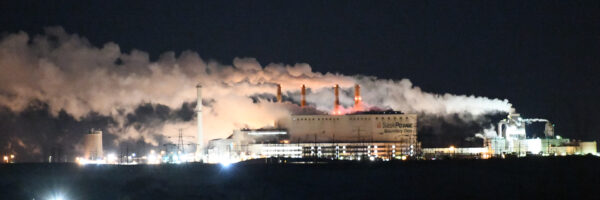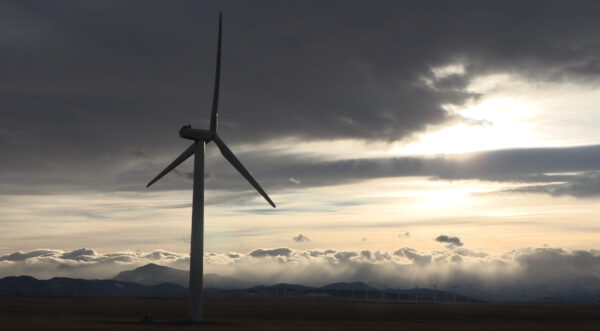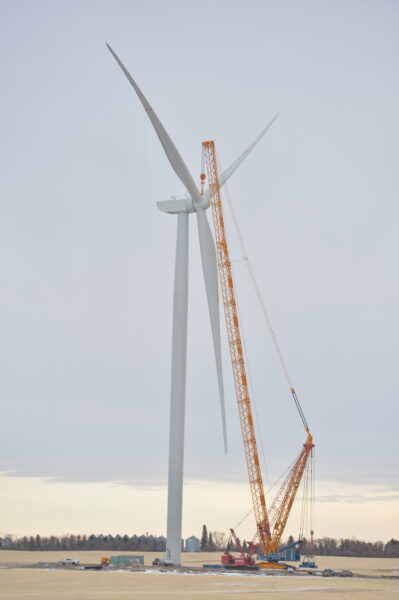Brian Zinchuk: Alberta won the energy lottery, yet it had to beg its neighbours if they could spare a megawatt.
Also:
Quick Dick McDick goes cooking with The Dam Smokehouse
Brian Zinchuk: Alberta won the energy lottery, yet it had to beg its neighbours if they could spare a megawatt.
Also:
Quick Dick McDick goes cooking with The Dam Smokehouse

The past weekend proved to be a close-run thing for the Alberta electrical grid, and Saskatchewan Premier Scott Moe is making statements resolving he won’t allow that to happen here.
Specifically, after having nearly completely divested itself of coal-fired power production, Alberta’s dramatic buildout of wind and solar proved impossible to keep the lights on in that province when the chips were down and temperatures hit -35 C, or worse.
Alberta’s close brush with possible rolling blackouts stiffens Moe’s resolve to keep the lights on. On Monday, he announced that SaskPower has relit a shuttered coal unit near Estevan, one the feds had supposedly forced to retire Dec. 31, 2021.
Also note: Saskatchewan has about a million cars registered. So a good bet is Alberta probably has four million. What would have happened if four million EVs were all plugged in last weekend?
If you missed them, these five stories, in order, chronicle what happened in Alberta.
Most of Alberta’s wind fleet slowly shut down Thursday night, but not for lack of wind
Grid Alert 1:
Alberta goes under grid alert for just under 5 hours on Jan. 12
Grid Alert 2:
Grid Alert 3:
Alberta goes into Round 3, with its third electrical grid alert in three days
Grid Alert 4:
Round 4: Alberta declares fourth electrical grid alert in 4 days, second in 17 hours


For the third day in a row, Alberta went into an electrical grid alert on Sunday. At one point it had no contingency reserve left at all, but imports from BC appeared to save the day. While it looked a little hairy there for a bit, there was no emergency alert declared, unlike Saturday.
Did I mention before that Alberta has more coal, oil and natural gas than God? Because guess what? It still does.

Alberta’s electrical grid stood at the brink of blackouts Jan. 13, before pulling back in the nick of time.
It was the second evening in a row Alberta saw “grid alert” issued, but this time, it was a much closer-run thing.
Alberta’s electrical grid was in such peril of falling into rotating blackouts on Saturday night, the provincial government urged people to even turn off their bathroom fans, among other things.
Also, from Western Standard:
STIRLING: When magical thinking meets a polar vortex cold, hard reality follows

Most of Alberta’s wind fleet slowly shut down Thursday night, but not for lack of wind.
And by 7:28 a.m., as -31 C covered most of the wind generating areas, wind power generation fell to less than 1 per cent, again.

How exactly did Alberta end up with $0 power on Dec. 26? Alberta Electric System Operator explains

Danielle Smith asks ‘Is Canada Broken?’ in a video targeted at Steven Guilbeault’s environmental policies.

UPDATED: For seven days in a row, SaskPower saw wind generation hit zero for part of the day
The story originally said five days. SaskPower got back to me and noted the streak continued Jan. 7 and 8 as well. So that’s a whole week with wind flatlining. Total, complete flatline for part of the day, each day. How do you power the hospital my wife is an ER nurse at with zero power? Inquiring minds would like to know?
Also:
Weaker oil prices should bring some relief to consumers in 2024: Analysts
and
Quick Dick McDick: Saskatchewan Winterfront Regulation
Bonus points for Quick Dick’s instruction on how to use the box from a Pilsner 2-4 for a winterfront. Nothing says Saskatchewan like a Pil box on your pickup

It’s starting to get cold out. The sun was down and Alberta’s wind power generation fell to next to nothing last night – less than half a per cent capacity.
Meanwhile in Saskatchewan, we’ve had several days of minimal wind power generation.
In other news, they’ve started to bring in floating accommodations for the staff to build the Woodfibre LNG facility.
And Precision Drilling meets debt reduction goal, on track to repay $500 million by 2025.

Wind power flatlined in Saskatchewan on Jan. 2, after days of strong winds. Flatlined, as in zero power, at night, so no solar, either.
Zero reliability, this wind thing. And I had to start wearing my parka this week, too.
Put our trust in wind, and we’ll all freeze. In the dark.
Also, switching to third person:
Pipeline Online editor and owner Brian Zinchuk is back on the air with CJME/CKOM’s Evan Bray Show. He was on the air for a full hour on Wednesday, Jan. 3. Here’s the podcast of that appearance, including responses to several calls. One was on whether or not the Trans Mountain Expansion will ever be finished. (With the ads and news breaks removed, it’s only 35 minutes).
Saskatchewan’s Year in Energy: Premier Scott Moe, 2023: Full Interview
If you didn’t have a chance to see this interview posted in four pieces before, here is the full year-end interview between Premier Scott Moe and Pipeline Online editor and owner Brian Zinchuk
Also, Premier Scott Moe’s social media folks posted the Pipeline Online story about the carbon tax on Saturday:
Saskatchewan families can say so long to paying the carbon tax on home heating beginning on Monday!https://t.co/y2ZC7fLaSN
— Scott Moe (@PremierScottMoe) December 30, 2023
That bill there is directly from my father’s Jan. 2023 bill, when the carbon tax was still $50 per tonne. In April, it’ll be $80 a tonne. Without getting into too much detail, the shop that was connect to his natural gas is no longer. Thank God.
It was rather entertaining to read some of the comments, like suggesting my 80-year-old father should pay for upgrading the heating on his home (with only his meager CPP and OAS). Because every 80 year old will see a return in 10 years on such an investment. Certainly.
Another suggested he must be in a high income bracket – nothing could be further from the truth. Or that Trudeau’s climate action cheques must be enough to compensate.
True believers, those.
Anyhow, happy new year, everyone! And if you live in Saskatchewan and have SaskEnergy or SaskPower for home heating, happy no more carbon tax, on that, at least, year!

So long, carbon tax on home heating in Saskatchewan!
And that’s what my dad, an 80-year-old retired farmer pensioner, paid in carbon tax last January, when it was still $50/tonne. And April 1, it will be $80 per tonne. How the hell is he supposed to make those payments on the carbon tax? Just not eat? Thankfully, we removed the shop heating, so that will make a huge difference. Now the neighbour gets to deal with that.
Their German neighbours may have shut down their last nuclear reactors in 2023, but Poland is ALL IN when it comes to nuclear power. They’re building large reactors, small reactors, maybe even some micro (not sure on the last one). But they are going to be building 24 small modular reactors of the same design SaskPower has chosen. And that number might go up. I’ve seen references to as many as 70 BWRX-300s for Poland. One thing is clear – the manuals will be written in Polish before English, it seems. Meanwhile, Saskatchewan will not formally decide to go ahead or not until 2029. I’m not sure where they’re going to get their reactor fuel from, but they’ll be damned if they buy a pound from Russia. That puts Saskatchewan uranium in good stead for the possible supply – and with the numerous large reactors planned for Poland, plus all the SMRs, that’s a good, new, long-term market for us.
There are some days I think I’m kinda smart. But you get into a room, virtual or otherwise, with an Adam Waterman or a few others, and you realize how dumb you really are. Here’s what I mean.
Patchwork Podcast: Year-end roundup with Adam Waterman, Brian Zinchuk, Tracy Klotz and Kurt Price

If you don’t regularly watch Peter Zeihan, you should. He posted this on Christmas Day.
Wind bottoms out across 14 states in Southwest Power Pool SPP on Dec. 22
That also meant that of any electrons coming across the border at that time, if SaskPower was buying any power from SPP, 83.4 per cent of that power would have been coming from coal and natural gas, and would not have had a carbon tax applied to it.

It wasn’t that long ago, Crescent Point was pouring nearly all its capital budget into Saskatchewan, often employing over 20 drilling rigs in this province alone, and one in Alberta. My, how times have changed.
Its revised five year plan doesn’t even mention Saskatchewan by name.
The company has historically shown a pattern before it sells off an asset. It stops all drilling in that area months before a sale is announced. When I took Saskatchewan’s Minister of Energy for a tour west of Estevan, there wasn’t one rig drilling west of Estevan all the way to the Shaunavon area. When the photo above was taken in February, 2018, the company was running about 10 rigs in one township alone west of Estevan.
This is a key reason why I asked some hard questions of Premier Scott Moe about the lack of drilling activity in Part 2 of my year end interview with him (posted yesterday)
EDIT: Noting the lack of comments, let me provide some context: An enormous portion of Saskatchewan’s prosperity over the last 15 years, including its transition from a have-not to a have province, could be contributed to Crescent Point’s actions from 2007-2020. In 2008, they spent about a billion on land sales alone, then many, many more billions in the subsequent years developing that land through intense drilling efforts. For a while around 2012-ish they were Saskatchewan’s largest oil producer. Through a series of something like 30 mergers and acquisitions, the company built up a huge land base in this province, principally in southeast Saskatchewan. For several years, they were the top drilling oil producer in all of Canada, often employing more rigs than No. 2 and 3 combined. And usually all but one of those rigs were working in this province.
Now that is dramatically diminished. They’re milking Saskatchewan but spending substantially less here. I won’t say minimal, but it is a huge, huge, difference. So when they’ve found a new lover, as it were, in Alberta’s Duvernay and Montney plays, that might be good for them, but not so much for us left out here in the frozen barren wasteland of southeast Saskatchewan.
Get it now?
The old bumper sticker used to say something like, “Lord, please grant me another oil boom, and I promise not to piss it away this time.”
The "one more oil boom" bumper sticker is back. #Alberta pic.twitter.com/PgAcALrAgr
— Justin Giovannetti (@justinCgio) September 20, 2016
Well, oil prices were up in 2023, but oil drilling in Saskatchewan certainly didn’t reflect that. So Pipeline Online asked Premier Scott Moe what Saskatchewan is going to do about it.
Saskatchewan’s Year in Energy: Premier Scott Moe, 2023: Part 2 Oil Drilling, or Lack Thereof
Across the border to the west, The last coal-fired power station in Alberta will soon be out of coal. A few weeks ago, a notice posted to the the Alberta Electric System Operator website provided an update on its conversion to natural gas.
The end of coal-fired power in Alberta is nigh
Also, from Canadian Press:
Regulator denied Trans Mountain variance request due to pipeline safety concerns
And this one is a doozy. This is the Liberal government trying to cement into place carbon pricing so that even if the government changes, nothing can be done about it.
Feds sign first carbon contract for difference with Calgary-based Entropy

Energy, and the “energy transition” being forced upon Canadians by the federal government, is becoming the dominant story, affecting all our lives and everything we do. In his year-end interview with Saskatchewan Premier Scott Moe, Pipeline Online dives deep into the biggest energy issues of the past year.
This is Part 1: Fighting the Feds.
Part 2 will focus on addressing low oil drilling activity, despite decent oil prices.
Part 3 discusses the Clean Electricity Regulations and their impact, and widespread adoption of nuclear power.
Part 4 talks about lithium and helium development, and ends with Christmas greetings.